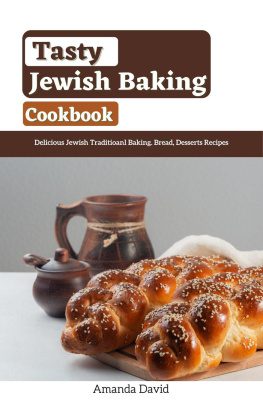Contents
Guide
Oishisou!! The Ultimate Anime Dessert Cookbook
by Hadley Sui
Over 60 Recipes for Anime-Inspired Sweets & Treats
To my host families in Yoshikawa, who were kind enough to bring me into their homes and into their lives as a daughter.
This book is intended to serve as an introduction to Japanese pastries as well as the many anime series that feature them. It is my hope that these recipes will expand your kitchens boundaries and inspire you to explore even more of Japans unique culinary traditions. Enjoy your impending confectionery adventures! Itadakimasu!
HADLEY SUI
INTRODUCTION: A FEAST FOR THE EYES
For many of its fans, Japanese animation, or anime, is a gateway into Japanese culture, and it can fuel a lifelong passion for studying the Japanese language and all facets of the nations daily life. Food is another entry point into this fascination with learning about Japans culture and beliefs. As foreign anime viewers, we are transported to our very own isekai (or parallel universe) full of exquisite foods that are often grounded in real traditions. These foods reveal the possibilities of new flavors and experiences that are waiting for us if we allow ourselves to get lost in a new way of thinking.
Pastry in particular is one of Japans most versatile art forms. The countrys pastries have the ability to capture the ever-changing beauty of the seasons and underline the transitory aspect of our experience of the world. Japanese pastries have ties to the traditional art of the tea ceremony (sad, or way of tea), but they are also influenced by various foreign cultures while maintaining their own unique ethos.
The recipes in this book are rooted in my research of traditional and nontraditional pastry, highlighted by anime and the role it plays in its native land. While living in Japan, I had the good fortune to be able to attend Japanese confectionary classes at Kyoto pastry institutions such as Kameya Yoshinaga, where I formed an appreciation for the process of pastry creation as well as a desire to share the art form with others. To reflect the fantastical nature of anime, some of the recipes in this volume draw upon nontraditional colors and forms; in these cases, their original appearance and context are noted.
Oishisou!! The Ultimate Anime Dessert Cookbook is a tribute to the expertise and creativity of Japans anime creators and its pastry chefs, written from the perspective of a mesmerized and hungry outsider looking in at their wonderfully sweet and addicting creations. Use these recipes as a launching point for creating the sweets seen in your favorite anime and exploring their connection to modern Japan.
JAPANESE PASTRY BASICS THE ORIGINS OF JAPANESE PASTRY
Japanese pastries tend to fall into two categories: wagashi and yougashi. The word kashi indicates confections, and originally referred to nuts and fruits. It is the basis for both of these terms. Wagashi are traditional Japanese sweets (wa indicates Japanese). The evolution of wagashi was influenced by the rise of the tea ceremony in Japan, as well as the Chinese tradition of dim sum. Japans very first wagashi are speculated to have been dango, or small ball-shaped sweets. They were most likely originated by people supplementing their diet with acorns due to an insufficient food supply. Raw acorns are too bitter to eat, so they were ground and soaked in water to lessen their bitterness, then cooked into spherical shapes. Dango have become a mainstay in Japans wagashi scene, though they are now typically made with rice flour and bean paste rather than acorns.
During the Nara period (710794 AD), ambassadors brought Chinese culture to Japan. It was at this time that deep-fried and boiled dumpling-style confections were introduced to Japan, though they were initially used primarily for offerings at shrines and temples. In addition to dango and dumplings, a third predecessor of wagashi was tenshin, a word derived from a Japanese Zen Buddhist term that means little things to add to the empty stomach. Monks consumed these foods, which included soups, dumplings, and noodles, to tide themselves over between meditation sessions. Because of their Buddhist origins, these foods were vegetarian, and they became todays ykan and manju. Today, wagashi are unique in their devotion to seasonality, often being influenced in both form and flavor by the subtleties of each season in Japan. Their designs and ingredients also draw inspiration from poetry, old and new, as well as pop culture.
Yougashi refers to Western-style sweets, such as cakes, which are often made with ingredients like white sugar and eggs. The popular strawberry shortcakes, crpes, and Swiss roll cakes are all considered to be yougashi. Nowadays, these treats are prevalent in Japan, with many shops specializing in cakes, breads, and more. Japanese ingredients and flavors are often incorporated into yougashi confections, such as breads made with mochiko rice flour and cakes flavored with matcha.
Nanbangashi, another term in Japans pastry taxonomy, are confections adopted from Portugal and Spain during the Muromachi period (13361573 AD), when missionaries came to Japan to facilitate trade and promote Christianity. A type of nanbangashi that is still popular is konpeito, a small crystal candy made from sugar instead of natural sweeteners like amazura (ivy sap) that were commonly used when wagashi were first introduced. Unlike the majority of previous wagashi types that were meant for the elite, nanbangashi were consumed by the general public.
In addition to displaying a keen attention to seasonality, Japanese pastries tend to reflect a sharp awareness and celebration of local flavors. Japans omiyage gifting culture revolves around hyper-local produce, flavors, and artisanal specialties. It is common to bring boxes of omiyage souvenir snacks back to family and friends after traveling. The countrys variety of terrains and climates allows for a wide range of produce to flourish, and its long tradition of artisan crafts has helped to elevate each regional specialty to its highest form. Many of the pastry varieties in this book have been adapted in Japan to reflect local flavors and heritage.
THE JAPANESE PASTRY PANTRY
Here are a few of the Japanese specialty pastry ingredients used in this book. These can be sourced at Japanese supermarkets such as Mitsuwa and at the Korean-American chain H Mart, or through online stores like Bokksu Grocery.
Anko
Anko, or adzuki bean paste, is made from boiling, crushing, and sweetening red adzuki beans. It is frequently used in Japanese pastries and can be purchased premade at Japanese grocery stores if you dont have time to make it yourself. Koshi an and tsubu an are types of anko.
Joshinko
Joshinko is a flour made from nonglutinous short-grain rice. It can result in chewier textures than















